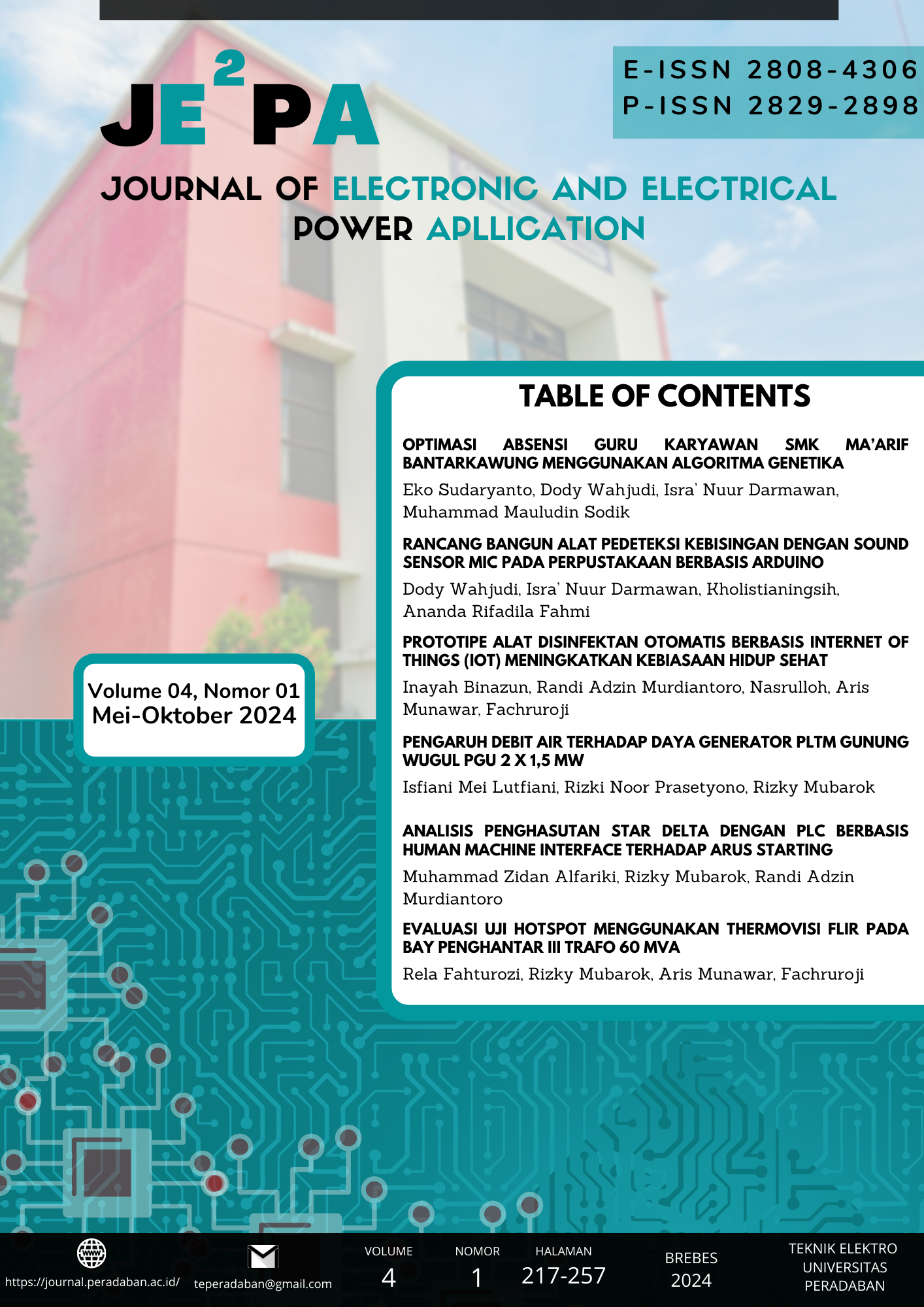PROTOTYPE OF AUTOMATIC DISINFECTANT TOOL BASED ON INTERNET OF THINGS (IOT) IMPROVES HEALTHY LIVING HABITS
DOI:
https://doi.org/10.58436/jeepa.v4i1.1911Keywords:
Automatic disinfectant, Covid 19, proximity sensor, Internet Of ThingsAbstract
Covid is currently starting to subside, one of which is with the handling, recommendation for vaccines from dose 1 dose 2 and booster vaccines. Handling and recommendation for vaccines is one form of government policy and is one of the government's responsibility efforts to the community. The use of disinfectants can be one solution for the community to start living a healthy and clean life, but many people are reluctant to bring disinfectants to public places. The existence of a prototype of an automatic disinfectant tool can provide a solution for people who are reluctant to bring disinfectants out of the house, even every community house can make an automatic disinfectant tool for indoor use. Based on the results and discussions above, it can be concluded that the design of the prototype of an automatic disinfectant sprayer with a proximity sensor based on the internet of things (IOT) to support healthy living habits after the pandemic has been successfully carried out. While the results of the efficiency of the proximity sensor detection time against objects were 86.3% with a proximity sensor error value of 2.1%. The prototype of an automatic disinfectant sprayer with a proximity sensor based on the internet of things (IOT) has successfully sent the results of the prototype disinfectant usage counter to the telegram. Although there are still many shortcomings in this study in building a prototype of an automatic disinfectant sprayer with a proximity sensor based on the internet of things (IOT), the overall system that was built can run well..
References
Sharpless, Norman E. "COVID-19 and cancer." Science 368.6497 (2020): 1290-1290.
Hornuss, Daniel, et al. "Anosmia in COVID-19 patients." Clinical Microbiology and Infection 26.10 (2020): 1426-1427.
Setiati, Siti, and Muhammad Khifzhon Azwar. "COVID-19 and Indonesia." Acta Medica Indonesiana 52.1 (2020): 84-89.
Olivia, Susan, John Gibson, and Rus’ an Nasrudin. "Indonesia in the Time of Covid-19." Bulletin of Indonesian economic studies 56.2 (2020): 143-174.
Larasati, Annisa Lazuardi, and Chandra Haribowo. "Penggunaan desinfektan dan antiseptik pada pencegahan penularan COVID-19 di masyarakat." Majalah farmasetika 5.3 (2020): 137-145.
Desiyanto, Fajar Ardi, and Sitti Nur Djannah. "Efektivitas mencuci tangan menggunakan cairan pembersih tangan antiseptik (hand sanitizer) terhadap jumlah angka kuman." Kes Mas: Jurnal Fakultas Kesehatan Masyarakat Universitas Ahmad Daulan 7.2 (2013): 24934.
Rahmatullah, Slamet, W. Agustin, and N. Kurnia. "Formulasi dan Evaluasi Sediaan Gel Hand Sanitizer sebagai Antiseptik Tangan dengan Variasi Basis Karbopol 940 dan Tea." Chmk Pharmaceutical Scientific Journal 3.3 (2020): 189-194.
Laghari, Asif Ali, et al. "A review and state of art of Internet of Things (IoT)." Archives of Computational Methods in Engineering (2021): 1-19.
Mouha, Radouan Ait Radouan Ait. "Internet of things (IoT)." Journal of Data Analysis and Information Processing 9.02 (2021): 77.
Musafira, Fardinah, et al. "Edukasi Pembuatan Dan Penyemprotan Desinfektan Pada Masyarakat Di Desa Suruang Kecamatan Campalagian Kabupaten Polewali Mandar." Community Development Journal: Jurnal Pengabdian Masyarakat 1.3 (2020): 416-421.
Wibowo, Ilham Sakti, and Muhammad Ishamuddin. "Mesin Pengisian Botol Minuman Bir Pletok Secara Otomatis Berbasis Internet of Things (IoT)." Seminar Nasional Teknik Elektro. Vol. 4. No. 3. 2019.
Fatmawati, Kiki, et al. "Rancang bangun tempat sampah pintar menggunakan sensor jarak berbasis mikrokontroler Arduino." Riau Journal Of Computer Science 6.2 (2020): 124-134.
Cheung, Lawrence. "Using the ADDIE model of instructional design to teach chest radiograph interpretation." Journal of Biomedical Education 2016.1 (2016): 9502572.
Evalina, Noorly, et al. "Penerapan pembangkit listrik tenaga surya pada robot penyemprot desinfektan." Prosiding Seminar Nasional Kewirausahaan. Vol. 2. No. 1. 2021.
Hartati, Herni, et al. "Rancang Bangun Sistem Penyemprot Disinfektan Otomatis Berbasis Iot Untuk Mencegah Penyebaran Virus Corona." Jurnal Digit: Digital of Information Technology 12.1 (2022): 33-43.
Harahap, Rima Gusriana, et al. "Pelatihan pembuatan eco-enzyme sebagai alternatif desinfektan alami di masa pandemi covid-19 bagi warga km. 15 Kelurahan Karang Joang." SINAR SANG SURYA: Jurnal Pusat Pengabdian Kepada Masyarakat 5.1 (2021): 67-73.
Desiyanto, Fajar Ardi, and Sitti Nur Djannah. "Efektivitas mencuci tangan menggunakan cairan pembersih tangan antiseptik (hand sanitizer) terhadap jumlah angka kuman." Kes Mas: Jurnal Fakultas Kesehatan Masyarakat Universitas Ahmad Daulan 7.2 (2013): 24934.
Chanthakit, Somphop, and Choopan Rattanapoka. "Mqtt based air quality monitoring system using node MCU and node-red." 2018 Seventh ICT International Student Project Conference (ICT-ISPC). IEEE, 2018.
Singh, Kamna, and Deepa Bura. "Internet-of-Things (IoT): distinct algorithms for sensor connectivity with comparative study between node MCU and arduino UNO." NVEO-NATURAL VOLATILES & ESSENTIAL OILS Journal| NVEO (2021): 4313-4324.
Danny, Muhtajuddin. "Implementasi Sistem Monitoring Absensi Berbasis Rfid Proxymity." Jurnal SIGMA 11.3 (2020): 175-178.
Ferdiansyah, jefry. Implementasi sensor proximity pada racang bangun alat poka yoke berbasis plc omron cp1e. Diss. Politeknik Negeri Sriwijaya, 2022.










